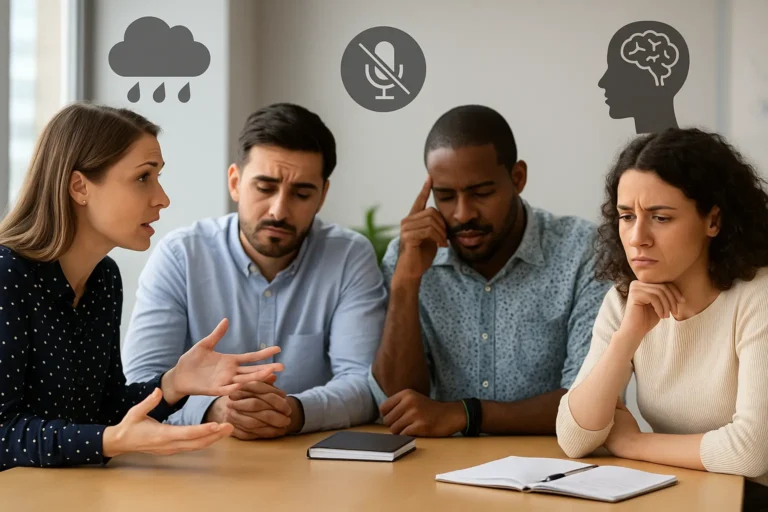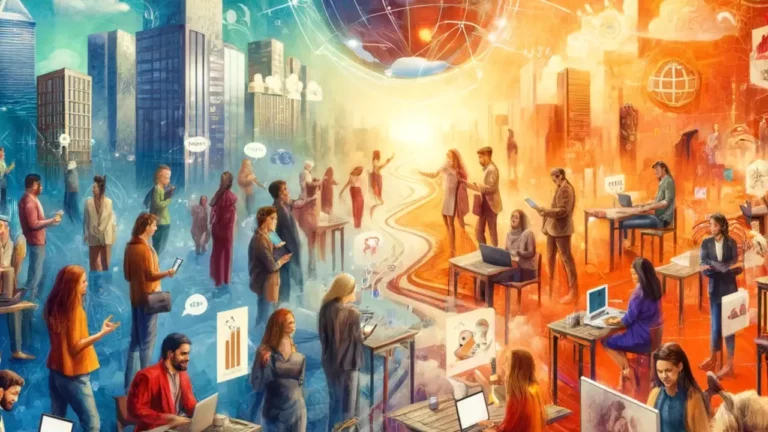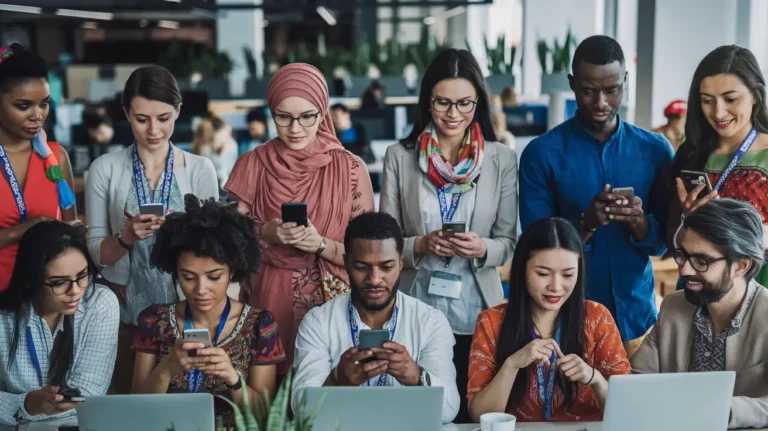Social Barriers to Communication
Social barriers to communication are real obstacles that can keep people apart—at work, in school, at home, or even online. Sometimes the problem is easy to see, like language differences. But often, social barriers are hidden in group dynamics, power imbalances, implicit biases, or even in the tools we use to connect. Overcoming these barriers is key to building trust, fairness, and understanding in any group or organization.
What Are Social Barriers to Communication?
Social barriers to communication are the forces in society that make it hard for people to share ideas, feelings, or information. These obstacles come from language, culture, status, ability, personal biases, and even technology. They block or distort messages, leading to misunderstandings, exclusion, and lost opportunities.
Social barriers show up in many forms. Someone might be left out because of their social identity—such as race, gender, class, or age—or because of a disability. Power differences in a workplace or classroom might keep people from speaking up. Even subtle things, like a manager’s unconscious bias or a quick remark (microaggression), can silence a team member. And in our digital age, lack of internet access or comfort with technology creates new types of barriers.
Types of Social Barriers to Communication
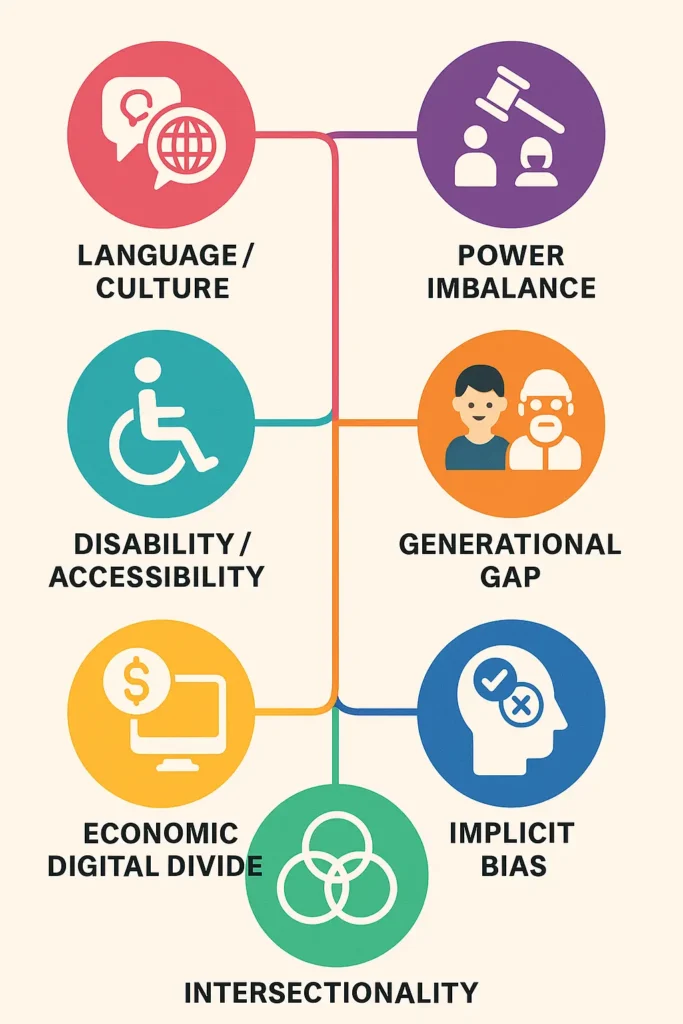
Language and Cultural Barriers
Language differences are a classic social barrier. Even within the same country, dialects, slang, or accents can cause confusion. Cultural traditions shape everything from eye contact to humor. In some cultures, it’s polite to speak directly; in others, it’s better to be indirect. These variations can easily lead to miscommunication.
Social identity and group membership also play a role. Sometimes, people feel like outsiders because of their background. This “in-group vs. out-group” dynamic can make others hesitant to speak or participate.
Power Imbalances and Hierarchy
Power structures in families, workplaces, and schools often affect who feels comfortable sharing ideas. Power imbalances and strict hierarchies can silence minority voices or those with less status. For example, a junior employee may not feel safe questioning a supervisor, or a student may not feel heard by a teacher.
Psychological safety—the sense that it’s okay to make mistakes or offer new ideas—helps break these barriers. When people know they won’t be punished or ridiculed, they’re much more likely to contribute honestly.
Disability and Accessibility
Not all barriers are visible. People with physical, sensory, or cognitive disabilities often face obstacles that others don’t notice. Lack of sign language interpreters, missing captions, or poor physical access are all accessibility barriers. Inclusive design and reasonable accommodations are essential for everyone to fully participate.
Generational Differences
Communication styles change from generation to generation. What works for Gen Z might confuse Baby Boomers, and vice versa. Generational barriers arise from differences in preferred communication methods (texting vs. phone calls), slang, or even attitudes toward technology.
Economic and Educational Barriers
People from different economic backgrounds may not have equal access to technology or education. Digital exclusion—not having internet, a computer, or digital literacy—can keep someone out of important conversations. Educational gaps affect vocabulary, confidence, and the ability to communicate ideas.
Implicit Bias and Microaggressions
We all have implicit biases—unconscious attitudes or stereotypes that influence our actions. These often show up as microaggressions, which are subtle, often unintentional comments or actions that exclude or insult others. Even a casual remark can make someone feel unwelcome.
Intersectionality
Many people experience multiple barriers at once. Intersectionality means looking at how different aspects of identity—like race, gender, disability, or class—combine to shape each person’s experience. For example, a woman of color with a disability may face different communication barriers than a white man without a disability.
Social Media and Digital Communication
Digital tools are great for connecting people, but they also introduce new social barriers to communication. Online, it’s easy to misread tone or intent. Some people face cyberbullying or digital harassment. Others are left out due to lack of access or comfort with technology.
Causes of Social Barriers
Social barriers are shaped by a complex mix of factors:
- Social identity and group dynamics: Feeling like an outsider in any group makes communication harder.
- Power imbalance and hierarchy: Authority gradients stop some voices from being heard.
- Accessibility gaps: Not everyone has equal access to spaces, tools, or information.
- Implicit bias and stereotypes: Unconscious assumptions keep people from listening fairly.
- Economic and educational inequality: Not everyone has the same resources or opportunities to learn communication skills.
- Generational and digital gaps: Age and comfort with technology create their own divides.
- Lack of psychological safety: Fear of negative consequences keeps people silent.
Effects of Social Barriers to Communication
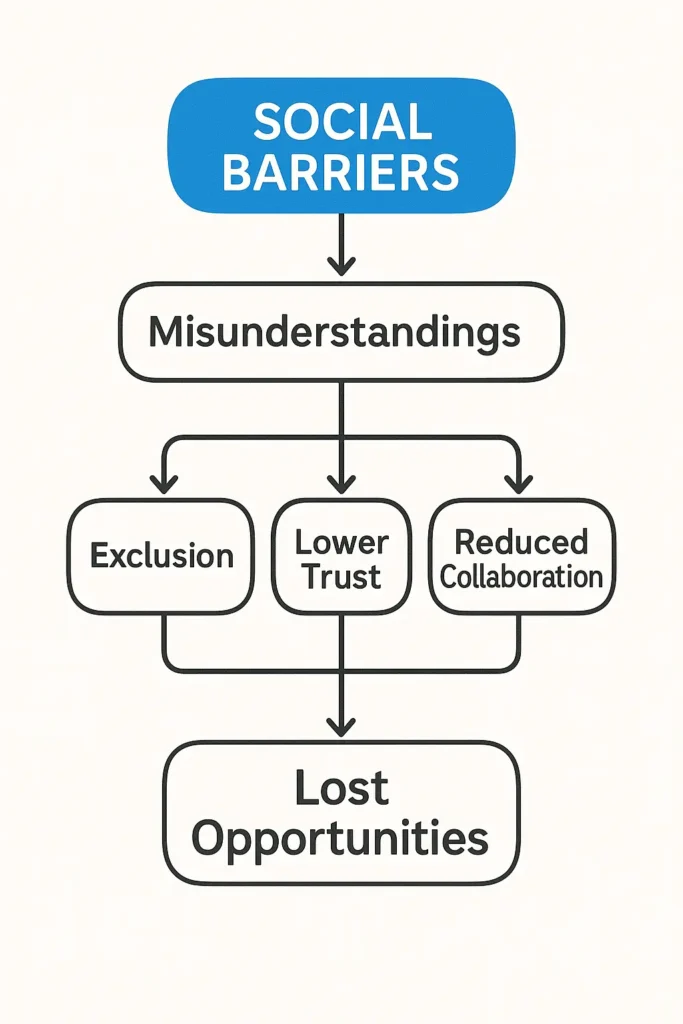
Impact on Relationships
Social barriers often result in misunderstandings, isolation, or conflict—even among friends or family. In-group favoritism, exclusion, and microaggressions can erode trust and damage relationships.
Impact on Society
On a bigger scale, social barriers to communication limit who gets to participate in decision-making or share ideas. When people from certain backgrounds are left out, we lose valuable perspectives. This weakens communities and reinforces inequality.
Impact on Business and Education
At work, social barriers can kill creativity and teamwork. When certain groups are silenced or excluded, businesses miss out on innovation and risk employee turnover. In schools, social barriers lower student engagement and limit learning for those who feel different or excluded.
Overcoming Social Barriers to Communication
Build Psychological Safety
Make it clear that everyone is welcome to speak, ask questions, and even make mistakes. Leaders and teachers should model respect and gratitude for all input.
Address Power Imbalances
Flatten hierarchies where possible. Use anonymous surveys, suggestion boxes, or group facilitation to give everyone a voice. Encourage leaders to ask for input from all team members, especially those who might feel hesitant.
Promote Accessibility and Inclusive Design
Offer sign language interpreters, closed captions, and accessible documents. Use plain language and visual aids to support those with different abilities or learning styles.
Tackle Implicit Bias and Microaggressions
Provide regular training on recognizing and interrupting bias. Encourage self-reflection and honest conversations about language, assumptions, and fairness.
Encourage Cross-Generational and Cross-Group Mentoring
Pair people from different age groups, backgrounds, or abilities. Mentoring builds understanding and breaks down stereotypes.
Address Economic and Digital Divides
Provide free or low-cost access to technology and training in digital skills. Make sure everyone knows how to use the platforms chosen for group communication.
Regularly Measure Progress
Use climate surveys and anonymous feedback tools to track how people feel about communication in your group or workplace. Adjust policies and practices as needed.
Value Intersectionality
Be aware that some people face overlapping barriers. Make special effort to listen to and include those whose voices are often ignored.
Key Social Barriers and Solutions
| Barrier Type | Example | Solution |
|---|---|---|
| Language/Culture | Dialect, slang, eye contact norms | Cultural training, plain language |
| Power Imbalance | Senior staff dominate meetings | Anonymous Q&A, rotate facilitators |
| Disability/Access | No captions, poor physical access | Accessible documents, sign language |
| Generational | Older/younger staff misunderstand | Cross-generational mentoring, flexible tech |
| Economic/Digital | No computer or internet | Provide access, digital skills workshops |
| Implicit Bias | Favoring some voices over others | Bias training, anonymous surveys |
| Intersectionality | Overlapping identities and challenges | Listen, adjust, personalize support |
Conclusion
Social barriers to communication can show up anywhere. They are not always obvious, but their effects are real—limiting opportunity, hurting trust, and keeping some voices silent. Addressing social barriers to communication means more than just learning new skills; it’s about making space for everyone, valuing every perspective, and using tools that support inclusion. By tackling issues like power, bias, accessibility, generational differences, and digital divides, you can build stronger relationships and a fairer, more successful community or workplace.



